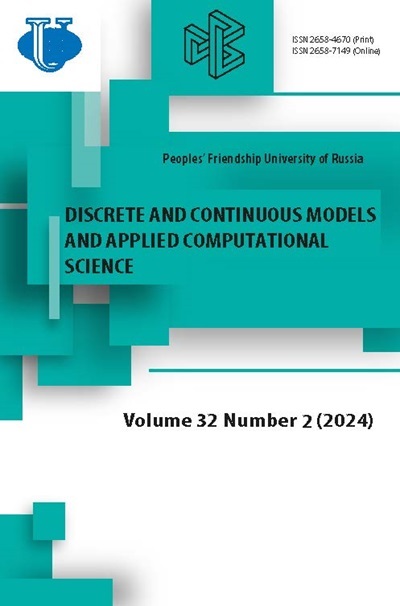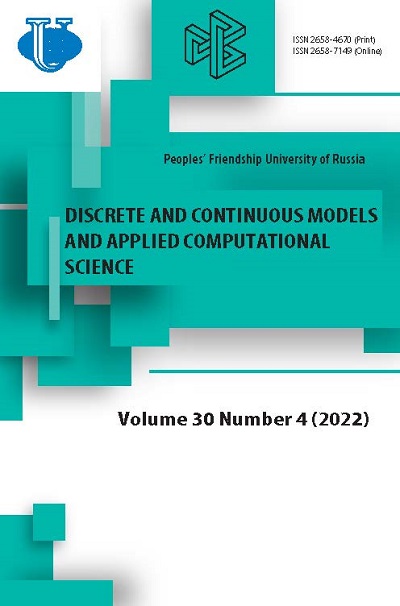Том 30, № 4 (2022)
- Год: 2022
- Статей: 7
- URL: https://journals.rudn.ru/miph/issue/view/1605
- DOI: https://doi.org/10.22363/2658-4670-2022-30-4
Весь выпуск
Тензор проницаемостей в геометризованной теории Максвелла
Аннотация
Считается, что основным препятствием к применению римановой геометризации уравнений Максвелла является недостаточное количество параметров, задающих геометризованную среду. При классическом описании уравнений электродинамики в среде используется тензор проницаемостей, имеющий 20 компонент. При римановой геометризации тензор проницаемостей строится из риманового метрического тензора, имеющего только 10 компонент. Предполагается, что данное несоответствие мешает применению римановой геометризации уравнений Максвелла. В статье предложено определить, действительно ли недостаток компонент является критическим для применения римановой геометризации уравнений Максвелла. Для определения области применимости римановой геометризации рассмотрены наиболее распространённые варианты электромагнитных сред. Для них выписана структура диэлектрической и магнитной проницаемостей, определено количество значащих компонент для этих тензоров. Показано, что практически все рассмотренные типы электромагнитных сред требуют менее десяти параметров для описания тензора проницаемостей. При римановой геометризации уравнений Максвелла критическим является требование единичного импеданса среды. Обойти данное ограничение возможно путём перехода от полных уравнений Максвелла к приближению геометрической оптики. Показано, что риманова геометризация уравнений Максвелла применима для большого разнообразия типов среды, но только для приближения геометрической оптики.
 305-317
305-317


Реализация гиперболических комплексных чисел на языке Julia
Аннотация
Гиперболические комплексные числа применяются при описании гиперболических пространств. Одним из известных примеров таких пространств является пространство Минковского, играющее ведущее значение в задачах частной теории относительности, электродинамики. Однако такие числа не очень распространены в разных языках программирования. Представляет интерес реализация гиперболических комплексных чисел в языках научного программирования, в частности в языке Julia. В основе языка Julia лежит концепция множественной диспетчеризации (multiple dispatch). Эта концепция является расширением концепции полиморфизма для объектно-ориентированных языков программирования. Разработана библиотека для Julia, реализующая гиперболические комплексные числа. По результатам исследования можно сделать вывод об удобстве и естественности концепции множественной диспетчеризации в языках научного программирования.
 318-329
318-329


О дисперсионной кривой волновода, заполненного неоднородным веществом
Аннотация
В статье рассматривается связь между модами, бегущими вдоль оси волновода, и стоячими модами цилиндрического резонатора. Показывается, как данная связь может быть исследована с помощью системы компьютерной алгебры Sage. В работе мы исследуем эту связь и на её основе описываем новый метод построения дисперсионной кривой волновода с оптически неоднородным заполнением. Целью нашей работы было выяснить, что могут дать системы компьютерной алгебры при вычислении (точек) дисперсионной кривой волновода. Метод построения дисперсионной кривой волновода с оптически неоднородным заполнением, предложенный нами, отличается от предложенных ранее тем, что сводит эту задачу к вычислению собственных значений самосопряжённой матрицы, то есть к задаче, хорошо изученной. Использование самосопряжённой матрицы исключает возникновение артефактов, связанных с появлением малой мнимой добавки у собственных значений. Мы составили программу в системе компьютерной алгебры Sage, в которой реализован этот метод для волновода прямоугольного сечения с прямоугольными вставками, и протестировали её на SLE-модах. Полученные результаты показали, что программа успешно справляется с вычислением точек дисперсионной кривой, отвечающих гибридным модам волновода, и найденные точки с графической точностью ложатся на аналитическую кривую даже при небольшом числе учитываемых базисных элементов.
 330-341
330-341


Об одной модификации метода Хемминга суммирования дискретных рядов Фурье и её применение для решения задачи коррекции термографических изображений
Аннотация
В работе рассматриваются математические методы коррекции термографических изображений (термограмм), полученных с помощью тепловизора, в виде распределения температуры на поверхности исследуемого объекта. Термограмма воспроизводит изображение тепловыделяющих структур, расположенных внутри исследуемого объекта. Это изображение передаётся с искажениями, так как источники, как правило, удалены от его поверхности и распределение температуры на поверхности объекта передаёт изображение как размытое за счёт процессов теплопроводности и теплопереноса. В работе в качестве принципа коррекции рассматривается продолжение функции температуры как гармонической функции с поверхности вглубь исследуемого объекта с целью получения функции распределения температуры вблизи источников. Такое распределение рассматривается как скорректированная термограмма. Продолжение функции температуры осуществляется на основе решения задачи Коши для уравнения Лапласа - некорректно поставленной задачи. Построение решения проводится с использованием метода регуляризации Тихонова. Основная часть построенного приближённого решения представлена в виде ряда Фурье по собственным функциям оператора Лапласа. Дискретизация задачи приводит к дискретным рядам Фурье. Для суммирования рядов Фурье и вычисления коэффициентов в работе предложена модификация метода Хемминга.
 342-356
342-356


Синтез толщины профиля тонкоплёночной волноводной линзы Люнеберга
Аннотация
В работе показана связь между фокусирующей неоднородностью эффективного показателя преломления волноводной линзы Люнеберга и неравномерностью толщины волноводного слоя, порождающей эту неоднородность. Для закона дисперсии нерегулярного тонкоплёночного волновода в модели адиабатических мод волновода решается задача математического синтеза и компьютерного проектирования профиля толщины волноводного слоя для тонкоплёночной обобщённой волноводной линзы Люнеберга с заданным фокусным расстоянием. Расчёты ведутся в нормированных специальным образом координатах для адаптации используемых соотношений к компьютерным расчётам. Полученное решение сравнивается с таким же решением в рамках метода сечений. Работоспособность алгоритма, реализованного в Delphi, была продемонстрирована путём построения дисперсионных кривых и семейства дисперсионных кривых, показывающих критическую сходимость. В качестве дополнительного результата были синтезированы профили толщины дополнительного нерегулярного по толщине волноводного слоя, образующего тонкоплёночную обобщённую волноводную линзу Люнеберга. Этот результат обобщает результаты Саутвелла.
 357-363
357-363


Консервативные конечно-разностные схемы для динамических систем
Аннотация
В статье представлена реализация одного из подходов к интегрированию динамических систем, при котором сохраняются алгебраические интегралы в оригинальной системе fdm for sage. Этот подход, восходящий к статье дель Буоно и Мастросерио, позволяет на основе двух любых явных разностных схем, в том числе любых двух явных схем Рунге-Кутты, сконструировать новый численный алгоритм интегрирования динамической системы, сохраняющий заданный интеграл. Этот подход реализован и протестирован в оригинальной системе fdm for sage. Обсуждены детали и трудности реализации. Для тестирования в качестве двух схем взяты две схемы Рунге-Кутты одного порядка, но с разными таблицами Бутчера, что не приводит к усложнению метода благодаря распараллеливанию. Рассмотрено два примера - линейный осциллятор и осциллятор Якоби, имеющий два квадратичных интеграла. На втором примере показано, что сохранение одного интеграла движения не приводит к сохранению другого. Проделанные эксперименты подтверждают, что данный подход может быть использован и при нестандартном выборе исходных схем. Более того, этот метод позволяет предложить практическое применение хорошо известной неоднозначности в определении таблиц Бутчера.
 364-373
364-373


Построение радиальной структуры неустойчивых ионно-звуковых колебаний во вращающейся замагниченной плазме при помощи уравнения эйконала
Аннотация
Рассмотрена задача о корректном асимптотическом построении радиальной структуры линейно неустойчивых собственных электростатических колебаний ионно-звукового типа, распространяющихся в однородном цилиндрическом столбе замагниченной плазмы вдоль осевого однородного магнитного поля. В цилиндрической области пространства координат сформулирована задача на собственные значения с краевыми условиями первого и второго рода (электродинамического и гидродинамического типа) для волнового уравнения ионно-звуковых колебаний. На основе базовых принципов геометрической оптики предложен метод построения дискретного спектра мелкомасштабных неустойчивых колебаний исследуемой системы, в основе которого лежит явное представление о типе краевых условий - проводимости и поглощающих свойствах стенки, ограничивающей плазменный цилиндр. При помощи уравнения эйконала получено дисперсионное соотношение для неустойчивых собственных мелкомасштабных мод, дестабилизированных за счёт эффектов дифференциального вращения - неоднородного по радиусу профиля угловой скорости ионов, вращающихся вокруг оси симметрии, вдоль которой направлен вектор индукции магнитного поля. Для корректного построения спектра дискретных инкрементов неустойчивых колебаний предложен универсальный рецепт подбора радиальных волновых чисел мелкомасштабных собственных мод в соответствии с каким-либо из типов краевых условий.
 374-378
374-378
















